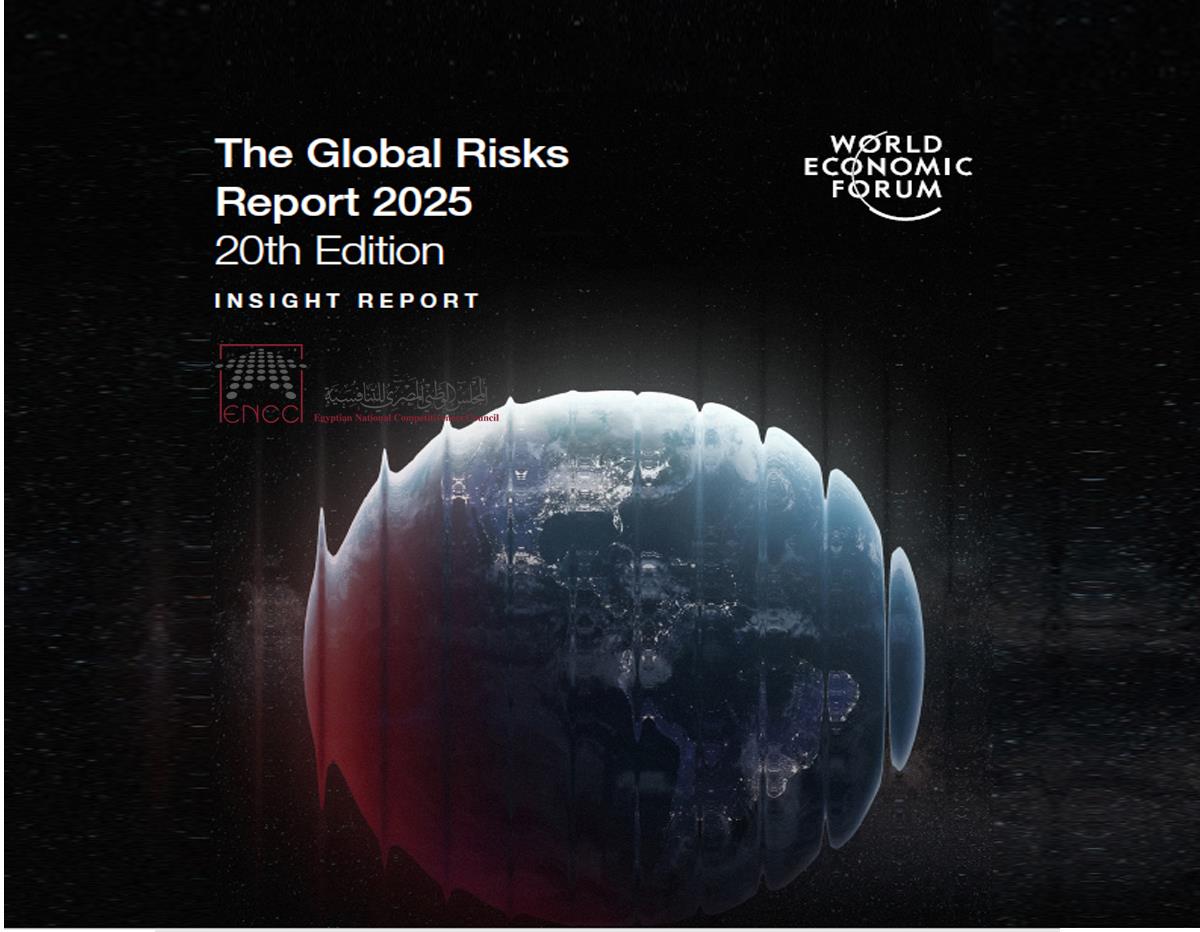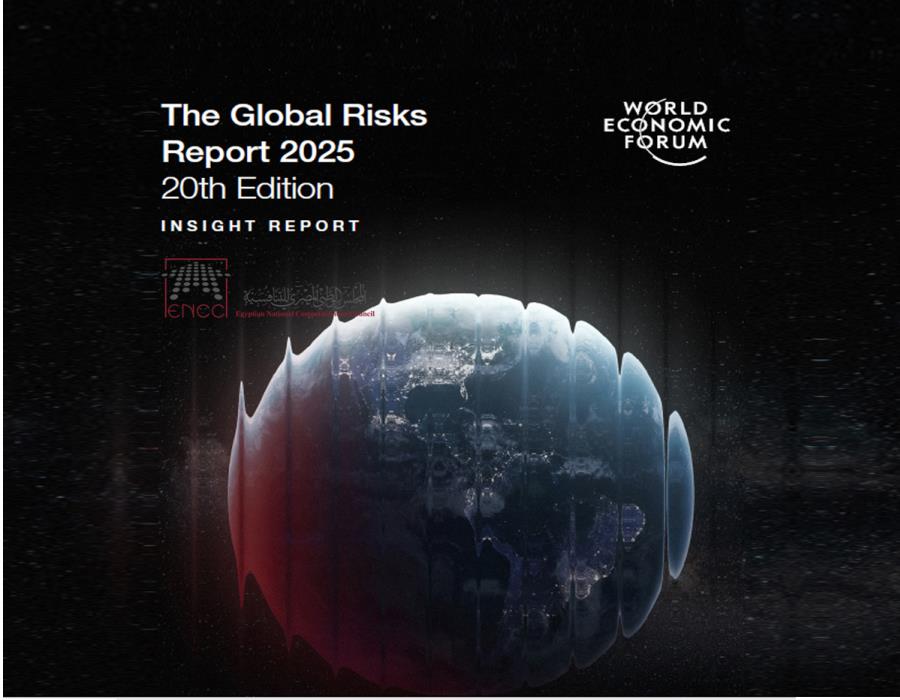The World Economic Forum’s Global Risks Report 2025: Curated Overview

The World Economic Forum’s Global Risks Report 2025: Curated Overview
1. Introduction
In its 20th edition, the World Economic Forum’s Global Risks Report 2025 sheds light on the evolving landscape of global risks. This landmark publication draws on insights from over 900 global leaders and experts, as well as more than 11,000 business executives worldwide, examining these risks across three distinct time horizons: the immediate term, the short to medium term, and the long term.
- Immediate (2025)
- Short to Medium Term (to 2027)
- Long Term (to 2035)
This overview, prepared for the Egyptian National Competitiveness Council(ENCC), highlights the report’s key findings, structural forces, and recommended actions. Its purpose is to foster deeper understanding and encourage proactive, collaborative solutions—essential for both global and national resilience.
2. Methodological Framework
The Global Risks Report 2025 uses a rigorous methodology to identify and assess risks:
- Global Risks Perception Survey (GRPS)
- Over 900 experts evaluated the likelihood and impact of 33 global risks across three time horizons: immediate (2025), short- to medium-term (to 2027), and long-term (to 2035).
- Executive Opinion Survey (EOS)
- More than 11,000 business leaders from 121 economies provided localized insights into top risks affecting their regions.
- Complementary Analyses
- Expert workshops and thematic reviews offered a multidimensional understanding of how these risks intersect and the strategies needed to address them.
3. Overview of the Global Risk Landscape
3.1 Immediate Risks (2025): Growing Divisions
- State-Based Armed Conflict
Conflicts in Ukraine, Sudan, and other regions amplify geopolitical tensions and humanitarian crises. - Extreme Weather Events
Floods, heatwaves, and storms continue to increase in frequency and severity, posing immediate threats to livelihoods and infrastructure. - Misinformation and Disinformation
Rapid advances in generative AI make it easier to produce and disseminate false information, undermining public trust and effective policymaking.
3.2 Short-Term Risks (to 2027): Intensifying Pressures
- Misinformation and Disinformation
Identified as the top short-term risk, it exacerbates social polarization and hinders crisis responses. - Extreme Weather Events
Severe climate disruptions persist, with mounting impacts on food security and global supply chains. - Societal Polarization
Deepening ideological divides strain governance, weaken social cohesion, and fuel unrest.
3.3 Long-Term Risks (to 2035): Potentially Irreversible Challenges
- Extreme Weather Events
Maintains the highest ranking over a decade, posing existential threats to ecosystems and economies. - Biodiversity Loss and Ecosystem Collapse
The second-highest long-term concern, stressing the irreversible impacts of environmental degradation. - Adverse Outcomes of AI Technologies
Unchecked AI advancements could lead to significant security, ethical, and employment disruptions.
4. Structural Forces Shaping Global Risks
Four overarching forces define the global risk environment:
- Technological Acceleration
Rapid developments in AI, quantum computing, and biotechnology outpace current regulatory frameworks, creating new vulnerabilities. - Climate Change
Escalating climate-related disasters, pollution, and biodiversity loss threaten both human and ecological well-being. - Geostrategic Shifts
A shift from a unipolar to a multipolar world intensifies competition among major powers, weakening multilateral governance. - Demographic Bifurcation
Ageing populations in developed economies face labor shortages and pension crises, while youthful populations in developing regions grapple with unemployment and migration pressures.
5. Thematic Insights: Compounding Effects
The report underscores several cross-cutting themes that magnify the scale and complexity of global risks:
- Environmental Pressures
- Pollution: Increasingly recognized for its underestimated impact on public health and natural habitats.
- Biodiversity Loss: Deforestation, habitat destruction, and climate change threaten food security and livelihoods.
- Societal Tensions
- Inequality: Rising economic disparities fuel social unrest and undermine stability.
- Super-Ageing Societies: Mounting healthcare and pension costs create fiscal pressures and intergenerational tensions.
- Technological Disruptions
- AI Misuse: Generative AI complicates efforts to curb misinformation and disinformation.
- Biotech Risks: Ethical dilemmas around genetic engineering and potential misuse for hostile purposes.
- Economic Fragmentation
- Geoeconomic Confrontation: Trade wars, sanctions, and protectionism erode global cooperation, heightening volatility in international markets.
6. Lessons from the Past
Reflecting on two decades of global risk analysis, the report identifies persistent and emerging patterns:
- Environmental Risks
Once viewed as distant threats, these have rapidly escalated into immediate concerns. - Technological Risks
Evolving swiftly from simple cybersecurity issues to complex AI and biotech governance challenges. - Geopolitical Risks
Ongoing conflicts and shifting alliances underscore the fragility of global cooperation.
These lessons underscore the importance of early risk detection, long-term planning, and resilient governance structures.
7. Call to Action: Strengthening Collective Resilience
The Global Risks Report 2025 concludes with a set of strategic recommendations to address imminent and long-range challenges. These actions are highly relevant not only at the global level but also for national bodies such as the Egyptian National Competitiveness Council.
7.1 Strengthening Multilateral Governance
- Reinvigorate Institutions
Enhance the mandates of entities like the United Nations, World Health Organization, and World Trade Organization to better address cross-border challenges. - Global Treaties and Agreements
- Climate Action: Accelerate measures under the Paris Agreement.
- Technology Regulation: Collaborate on frameworks for AI, biotechnology, and cyber governance.
Outcome: More robust and equitable responses to global crises, with stronger institutional legitimacy.
7.2 Investing in Resilience
- Infrastructure Upgrades
Prioritize climate-resilient projects, especially in high-risk areas prone to extreme weather events. - Economic Stability
- Develop financial safety nets to cushion against economic fragmentation.
- Promote debt management strategies, particularly important for developing economies.
- Digital Security
Reinforce cybersecurity protocols to protect critical infrastructure and data.
Outcome: Systems better equipped to withstand shocks, ensuring stability and faster recovery.
7.3 Promoting Responsible Innovation
- Ethical Standards
Set global guidelines for AI, genetic engineering, and other emerging technologies. - Public-Private Partnerships
Align innovation with societal goals, ensuring that technological advancements serve the common good. - Transparency and Accountability
Introduce labeling and accountability measures for AI-generated content.
Outcome: Harnessing the benefits of innovation while reducing risks to security and ethical norms.
7.4 Accelerating Environmental Action
- Net-Zero Pathways
Commit to renewable energy adoption and carbon-neutral policies. - Biodiversity Protection
Invest in reforestation and habitat restoration programs. - Pollution Reduction
Implement stringent controls on industrial pollutants and plastic waste.
Outcome: Mitigating climate impacts, protecting ecosystems, and preserving natural resources.
7.5 Building Social Cohesion
- Combat Misinformation
Raise public awareness and foster media literacy to counter false narratives. - Inclusive Policies
- Enact social safety nets to address inequality.
- Expand education and upskilling initiatives to prepare for the future of work.
- Youth Engagement
Encourage young people to participate in policy decisions, especially those affecting the environment and technology.
Outcome: Enhanced trust, reduced societal friction, and more robust collective problem-solving.
7.6 Fostering Leadership and Collaboration
- Visionary Governance
Policymakers must prioritize sustainable, long-term solutions over short-term gains. - Cross-Sector Partnerships
- Mobilize resources from government, private sector, and civil society.
- Encourage regional bodies (e.g., African Union, ASEAN) to lead targeted risk management efforts.
Outcome: Broader, more inclusive coalitions that can address complex risks effectively.
7.7 Enhancing Risk Literacy
- Education and Awareness
Integrate risk literacy into curricula to cultivate informed, proactive citizens. - Community Engagement
Establish local forums to discuss and strategize around risk preparedness.
Outcome: A well-informed population that supports and sustains resilience initiatives.
8. Conclusion
The Global Risks Report 2025 underscores the interconnected nature of modern threats—spanning geopolitical tensions, environmental crises, technological disruptions, and societal fractures. Addressing these risks requires unified global action, robust institutions, and forward-thinking leadership.
For the Egyptian National Competitiveness Council, these insights serve as a roadmap for national and regional resilience. By prioritizing responsible innovation, environmental stewardship, social cohesion, and strategic international partnerships, Egypt can strengthen its capacity to navigate and mitigate emerging global challenges—ultimately enhancing national competitiveness in an increasingly uncertain world.
Further Reading and Resources:
The complete Global Risks Report 2025 is available on the World Economic Forum’s website, offering interactive data tools and deeper analyses for policymakers, businesses, and civil society organizations.



23 Jan 2025 6:03 pm
Report is interesting to download